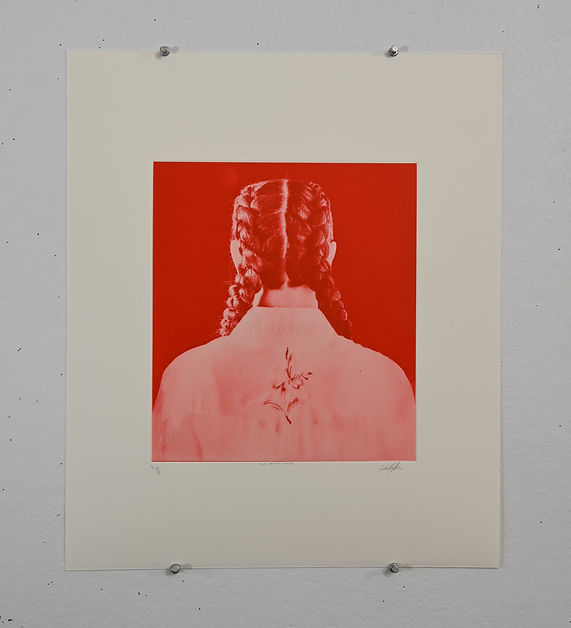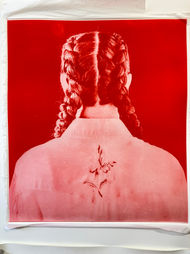editions
March 2023

Prairie Braids Series
Wally Dion
The print portrays an individual with their back towards the viewer. The source image belongs to a larger group of portraiture work embarked upon in 2019. The figure in these prints can be any gender and to some extent, any ethnicity. A prairie lily, the provincial flower of Saskatchewan, is embroidered into the back of the shirt. In this print, the individual has turned their back towards the viewer; referencing settler-Indigenous relations in the Saskatchewan judicial system.
For the artist; braids represent strength, culture and spirituality. Combing and braiding hair implies care, companionship and skill. Hair has long been a battleground for the church & settler power structures. In this way, braiding, washing or not washing, hair has become an act of resistance for Indigenous People.
Bullseyes are embossed into the some of the prints, referencing gun violence towards Indigenous Peoples.
A series of mixed media proofs from each edition have been made into unique works of art.
Some of these mixed media proofs have been incorporated into a brass frames that were cast on site, by the artist, at locations in the prairies where atrocities to Indigenous People occurred. The frames are made by melting discarded bullet shells and pouring the molten metal into a ‘soil’ cast in the ground. Remnants of the soil and stones from the casting process are embedded into the brass frame carrying the weight and memory intrinsically held by the earth. The use of brass bullets further emphasizes gun violence towards Indigenous People.

Up Where We Belong, 2020
Diptych installation at Remai Modern, Saskatoon
Listen to Wally describe the prints, their imagery and their meaning within the context of indigenous settler relations in Canada.

Brass frame made by the artist
from bullet shells.
Prairie Braids, based from a painting made in 2020 Up Where We Belong, is one of Dion's first venture into printmaking.
Having visited Jillian Ross Print in early October 2022 to see the studio and to learn more about printmaking and Ross's approach to collaborative printmaking, Wally decided to try out photogravure along side his other mediums - painting, drawing, tapestries, mixed media and installation based artworks.
With the help of Steven Dixon, who made the photogravure plate over the October Thanks Giving weekend, a new series of prints emerged. Over the coming months and regular trips to Saskatoon the print developed into four prints in red and black. Time and consideration was taken into develop the right look and feel for the print, experimenting with different papers and tonal ranges in color.
The making of the Prairie Braids at Jillian Ross Print.
These prints also exist as unique works made from brass frames.



Wally Dion
Prairie Braids and red Prairie Braids embossed,
Saskatoon frame (pour no. 1 & 2)2023
Print: photogravure on chine collé.
Frame: recycled brass, anodized aluminum
'The source image for Prairie Braids belongs to a larger group of portraiture work from 2019. The figure in these prints can be any gender and, to some extent, any ethnicity. A prairie lily, the provincial flower of Saskatchewan, is embroidered into the back of the shirt. In this print, the individual has turned their back towards the viewer, referencing Indigenous-settler relations in the Saskatchewan judicial system. Braids, though not explicitly belonging to them, are culturally and visually woven into Indigenous cultures; thus, we may assume the individual portrayed is Indigenous. For the artist, braids represent strength, culture, and spirituality. Combing and braiding hair implies care, companionship, and skill. Hair has long been a battle ground for the church and settler power structures. In this way, length of hair and braiding have become acts of resistance for Indigenous people. Bullseyes are embossed into some of the prints, referencing gun violence towards Indigenous people.' - Remai Modern
'Using a small portable propane forge, Dion melts down recycled bullet shells into molten brass and then casts frames directly in the soil. The location for these earth-casting projects is specific: sites/regions where acts of violence towards Indigenous peoples have occurred in the past.The first takes place in Saskatoon’s Starlight Toursdistrict, a rural area where Saskatoon Police were leaving Indigenous people to “walk it off” in -30°C winter conditions, essentially amounting to murder by hypothermia.' - Remai Modern
Published by Wally Dion
Collaborating Printer Jillian Ross
Photogravure by Steven Dixon
Editioning and image development at Jillian Ross Print
Editioning printers Master Printer Jillian Ross, assisted by Rowan Pantel and Brendan Copestake












